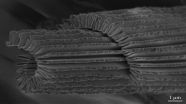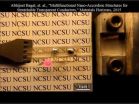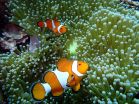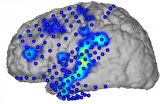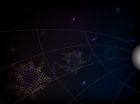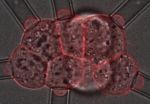(Press-News.org) Researchers from North Carolina State University have created stretchable, transparent conductors that work because of the structures' "nano-accordion" design. The conductors could be used in a wide variety of applications, such as flexible electronics, stretchable displays or wearable sensors.
"There are no conductive, transparent and stretchable materials in nature, so we had to create one," says Abhijeet Bagal, a Ph.D. student in mechanical and aerospace engineering at NC State and lead author of a paper describing the work.
"Our technique uses geometry to stretch brittle materials, which is inspired by springs that we see in everyday life," Bagal says. "The only thing different is that we made it much smaller."
The researchers begin by creating a three-dimensional polymer template on a silicon substrate. The template is shaped like a series of identical, evenly spaced rectangles. The template is coated with a layer of aluminum-doped zinc oxide, which is the conducting material, and an elastic polymer is applied to the zinc oxide. The researchers then flip the whole thing over and remove the silicon and the template.
What's left behind is a series of symmetrical, zinc oxide ridges on an elastic substrate. Because both zinc oxide and the polymer are clear, the structure is transparent. And it is stretchable because the ridges of zinc oxide allow the structure to expand and contract, like the bellows of an accordion.
"We can also control the thickness of the zinc oxide layer, and have done extensive testing with layers ranging from 30 to 70 nanometers thick," says Erinn Dandley, a Ph.D. student in chemical and biomolecular engineering at NC State and co-author of the paper. "This is important because the thickness of the zinc oxide affects the structure's optical, electrical and mechanical properties."
The 3-D templates used in the process are precisely engineered, using nanolithography, because the dimensions of each ridge directly affect the structure's stretchability. The taller each ridge is, the more stretchable the structure. This is because the structure stretches by having the two sides of a ridge bend away from each other at the base - like a person doing a split.
The structure can be stretched repeatedly without breaking. And while there is some loss of conductivity the first time the nano-accordion is stretched, additional stretching does not affect conductivity.
"The most interesting thing for us is that this approach combines engineering with a touch of surface chemistry to precisely control the nano-accordion's geometry, composition and, ultimately, its overall material properties," says Chih-Hao Chang, an assistant professor of mechanical and aerospace engineering at NC State and corresponding author of the paper. "We're now working on ways to improve the conductivity of the nano-accordion structures. And at some point we want to find a way to scale up the process."
The researchers are also experimenting with the technique using other conductive materials to determine their usefulness in creating non-transparent, elastic conductors.
INFORMATION:
The paper, "Multifunctional Nano-Accordion Structures for Stretchable Transparent Conductors," is published online in the journal Materials Horizons. The paper was co-authored by Erinn Dandley, Junjie Zhao, Xu Zhang, Christopher Oldham and Gregory Parsons of NC State. The work was supported NASA under grant number NNX12AQ46G.
Researchers from the ARC Centre of Excellence for Coral Reef Studies at James Cook University have discovered that suspended sediment damages fish gills and can increase the rate of disease in fish.
"Suspended sediments result from flood plumes, coastal agricultural and industrial development and from dredging operations and are increasing in coastal waters worldwide," says study co-author, Dr Amelia Wenger.
"Fish gills are in direct contact with their environment and are the first line of defence in the animal's immune response, which makes them the perfect place ...
University of Tokyo researchers have discovered the structure and transport properties of the "intermediate state" in lithium-ion batteries - key to understanding the mechanisms of charge and discharge in rechargeable batteries. These findings may help accelerate battery reaction speed and significantly shorten battery charging time.
Although there is strong demand to minimize battery-charging time, the mechanisms of battery charge and discharge reactions have yet to be fully understood. While the existence of an "intermediate state" that accelerates battery charge and ...
Researchers have discovered that extreme exercise can cause intestinal bacteria to leak into the bloodstream, leading to blood poisoning.
Experts at Monash University monitored people participating in a range of extreme endurance events, including 24-hour ultra-marathons and multi-stage ultra-marathons, run on consecutive days.
"Blood samples taken before and after the events, compared with a control group, proved that exercise over a prolonged period of time causes the gut wall to change, allowing the naturally present bacteria, known as endotoxins, in the gut to ...
A promising type of vaccine designed to eradicate malaria by blocking parasite transmission could be a step closer, as a result of experts uncovering new information about the targeted protein.
The international team of researchers co-led by Dr Natalie Borg from the Department of Biochemistry and Molecular Biology at Monash University, and Dr Rhoel Dinglasan from the Malaria Research Institute at the Johns Hopkins Bloomberg School of Public Health in Baltimore, USA, focused on a protein in the Anopheles mosquito midgut called AnAPN1.
The research, published in the journal ...
Restricting teenagers from driving unsupervised at night, and introducing strict penalties and other licensing requirements, could reduce crashes significantly, according to research.
Published in Health Affairs, the study by researchers from Monash University and Harvard Medical School, shows that driving laws that eliminate or deter unsupervised night driving by people younger than 18 achieve substantial reductions in car crashes.
Car crashes are the leading cause of death among people aged 15-19 worldwide. In the US, where the study was based, teen drivers experience ...
This news release is available in German.
Speech is produced in the human cerebral cortex. Brain waves associated with speech processes can be directly recorded with electrodes located on the surface of the cortex. It has now been shown for the first time that is possible to reconstruct basic units, words, and complete sentences of continuous speech from these brain waves and to generate the corresponding text. Researchers at KIT and Wadsworth Center, USA present their "Brain-to-Text" system in the scientific journal Frontiers in Neuroscience (doi: 10.3389/fnins.2015.00217). ...
For breast cancer to be fatal, the tumor has to send out metastases to other parts of the body. The cancer cells are spread via the blood vessels, and a research team at Lund University in Sweden has now proven that the protein ALK1 determines the extent of the tumor's spread in the body. The higher the levels of the protein on the surface of the blood vessels, the greater their permeability to tumor cells and therefore the greater the risk of metastases.
The new study also shows that the drug Dalantercept can prevent the spread of tumour cells in breast cancer by blocking ...
This news release is available in German.
In 1915 Albert Einstein formulated the theory of general relativity which fundamentally changed our understanding of gravity. He explained gravity as the manifestation of the curvature of space and time. Einstein's theory predicts that the flow of time is altered by mass. This effect, known as "gravitational time dilation", causes time to be slowed down near a massive object. It affects everything and everybody; in fact, people working on the ground floor will age slower than their colleagues a floor above, by about 10 nanoseconds ...
The same kind of contraction that fires our muscles also controls a key stage of mammalian embryo development, according to a new study published in Nature Cell Biology. The research, conducted at EMBL Heidelberg, measured and mapped how cells in very early stage embryos bond tightly together. The scientists also discovered a cellular behaviour that hadn't been observed before: cells in the embryo 'dance', each one making the same rhythmic movement.
The focus of the study was a stage of development known as compaction, which takes place when the embryo has eight cells. ...
In recent decades, enormous successes have been achieved in the field of public health. Three examples of these are the fight against HIV, the reduction in cardiovascular disease, and protection for non-smokers. For Germany to make even better use of the potential of public health, it needs more political support, improved research structures, and stronger international involvement. The German National Academy of Sciences Leopoldina, acatech - the National Academy of Science and Engineering, and the Union of the German Academies of Sciences and Humanities point this out ...
